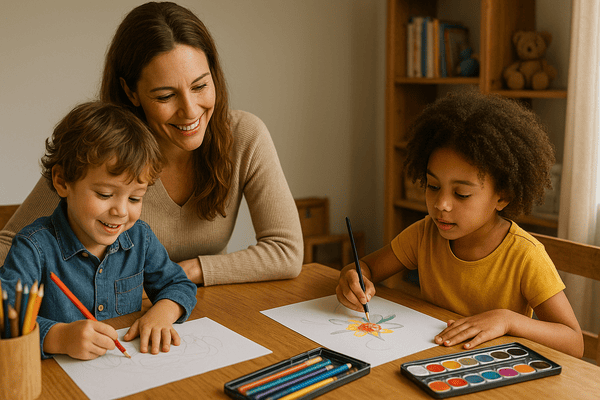Creativity is more than just drawing pictures or crafting projects. It’s a way of thinking, exploring, problem-solving, and expressing oneself. Encouraging creativity in your child helps build confidence, critical thinking skills, and emotional well-being.
Children who are encouraged to be creative are often better problem solvers, more adaptable, and more resilient. Here’s how you can nurture your child’s creativity at home, every day.
You might also like: How to Build a Strong Parent-Child Bond
Why Creativity Matters
Creativity helps children:
- Solve problems in unique ways
- Express emotions and ideas
- Build resilience and flexibility
- Develop confidence in their own abilities
Creativity is valuable not just in art, but in science, technology, communication, and many other areas of life.
Create a Safe and Supportive Environment
Children need to feel safe to take risks and explore new ideas. Let your child know that there’s no “right” or “wrong” way to be creative.
Encourage experimentation by saying:
- “That’s an interesting idea! Tell me more.”
- “Wow! I love how you tried something different.”
- “It’s okay if it didn’t work the way you expected. Let’s try another way.”
Avoid judging or criticizing their creative efforts. Focus on the process, not the result.
You might also like: How to Build a Strong Parent-Child Bond
Provide Access to Open-Ended Materials
Give your child materials that encourage imagination rather than prescribe one outcome. Examples include:
- Paper, crayons, markers, and paint
- Building blocks or LEGO®
- Playdough or clay
- Recyclable materials like boxes, bottles, and cardboard
- Fabric scraps, buttons, and craft supplies
Let your child decide what to make and how to use the materials. Open-ended play fosters creativity and decision-making.
Encourage Play and Imaginative Scenarios
Imaginative play is a key driver of creativity. Encourage your child to invent stories, play pretend, and create imaginary worlds.
Ideas include:
- Setting up a pretend store, school, or doctor’s office
- Creating characters with stuffed animals or dolls
- Building forts or obstacle courses
- Acting out favorite stories
Join in their play sometimes, but also give them space to create on their own.
Ask Open-Ended Questions
Spark your child’s thinking by asking questions that don’t have one “correct” answer:
- “What would happen if…?”
- “How else could we do this?”
- “What do you think the ending of the story could be?”
- “Can you invent a new game for us to play?”
These types of questions encourage problem-solving and flexible thinking.
Celebrate Effort and Originality
Focus on praising effort, creativity, and thinking — not just the final product.
Instead of saying:
- “That’s a pretty drawing.”
Try: - “I love how you used so many colors!”
- “You worked hard on that! Tell me about your idea.”
Celebrate originality and risk-taking. Let your child know that it’s great to try something new, even if it doesn’t turn out perfectly.
Allow for Unstructured Time
Children need downtime to let their minds wander and explore ideas freely. Avoid over-scheduling with too many structured activities.
Let your child have free playtime with no set agenda. Boredom can often lead to bursts of creativity as kids invent their own games or projects.
Introduce Them to Different Art Forms
Expose your child to a variety of creative experiences:
- Music and dance
- Theater and acting
- Painting and sculpture
- Storytelling and creative writing
- Photography and digital art
Visit museums, watch dance performances, listen to different music genres, or try new art projects together. The more exposure they have, the more creative inspiration they’ll find.
Encourage Storytelling and Writing
Whether through drawing, writing, or verbal storytelling, encourage your child to create stories.
- Start a family storytelling night
- Let them write and illustrate their own book
- Record their stories and play them back later
Storytelling helps build language skills, emotional expression, and imagination.
Allow Mistakes and Celebrate “Failures”
Mistakes are a natural part of creativity. Teach your child that failure isn’t something to fear — it’s part of learning and growing.
Say things like:
- “That didn’t work the way we planned — what should we try next?”
- “Sometimes the best ideas come from things that don’t go right the first time.”
- “It’s fun to experiment and see what happens!”
This mindset helps children become more resilient and willing to take creative risks.
Set an Example: Be Creative Yourself
Children are more likely to embrace creativity if they see you doing it too. Let them see you:
- Drawing
- Cooking new recipes
- Trying DIY projects
- Playing an instrument
- Writing stories or journaling
Share your creative process, including your mistakes and what you learn from them. Your enthusiasm will inspire them.
